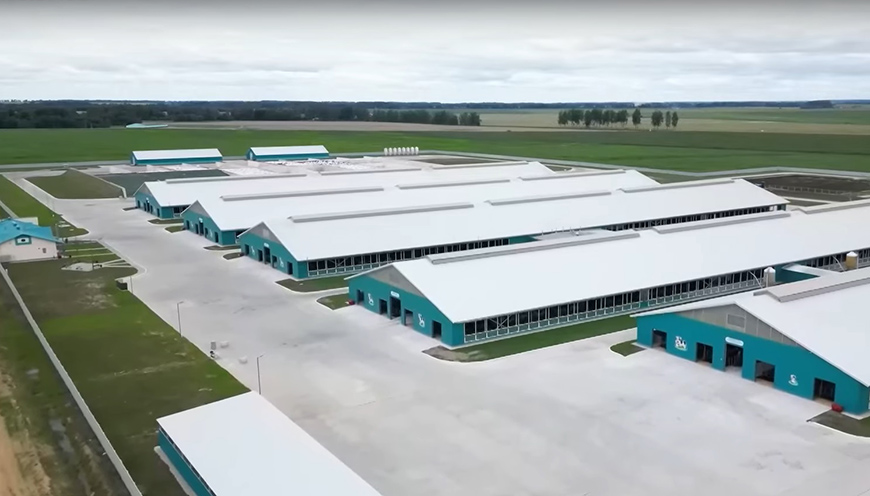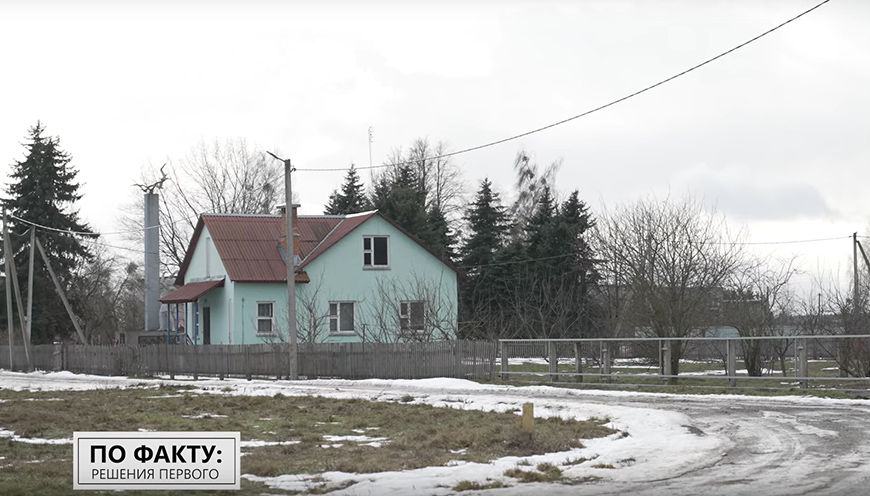
It was 2004. The national harvest festival-fair Dazhynki was wrapping up. Journalists asked the president's opinion on the harvest. They also inquired about the rural revival program which was not formalized officially thought it was in full swing. What were the plans of the government for the future? It was then when the president laid out his vision of a Belarusian agro-town... In the new episode of the YouTube project “After the Fact: Lukashenko’s Decisions” we will tell you how agricultural towns appeared in Belarus, what the president believes to be the everyday wisdom and what the village of the future will look like.
The state of the Belarusian agrarian sector in the 1990s
After the collapse of the Soviet Union, the agricultural reform envisaged abandoning the collective farming system. As a result, the fixed assets of agricultural enterprises almost halved in 1992-1994. The economic situation deteriorated. A shortage of personnel, price disparity and no money to pay wages. Wages in the sector averaged $10-12. The deep crisis required wise decisions of the first president of independent Belarus...
“The agricultural production was saved thanks to extraordinary measures, efforts to bring lands in order and to strengthen technological discipline. The national fund for support of agricultural producers, foodstuffs and agricultural science created in 1995 played a great role in this. So did similar local stabilization budget funds. The funds were mainly used to set up mechanized units and to acquire and improve physical assets of agricultural organizations. At that time, when resources were scarce, we thought about the ways to purchase something and keep it under one roof to maximize the efficiency and return on this equipment,” the head of state said at the visiting national seminar in Drogichin to discuss the progress in the state rural revival program for 2005-2010 in May 2005.
Transformation of Belarus’ agricultural sector in the 2000s
We managed not only to stop the decline, but also to improve the situation in the industry. The farms began to improve their technical capabilities, mainly thanks to domestic agricultural machines. By 2000, the average monthly salary in the industry more than tripled over 1995. The program to improve the agricultural industry was implemented from 2001 to 2005. Almost Br5 trillion of budget funds was allocated for it. The program defined not only the main areas of development of the agricultural industry but also ways to solve housing problems.

“We are going to develop large-scale agricultural farms of 5,000, 6,000 or10,000 hectares of land, etc. Thus we will be able to preserve villages. We will develop agro-towns. There will be three agro-towns per one large collective farm: one large community and two small ones. A small or medium-sized collective farm might have one agro-town. As for the so-called unpromising villages, in remote areas, I suggest we, government officials and businessmen, help them back on their feet,” Aleksandr Lukashenko said as he spoke to the students of Brest Oblast in September 2004.
What is the Belarusian agro-town?
The new approach to the development of the social welfare sector in rural communities was reflected in the state rural revival program for 2005-2010. It suggested transforming rural communities into well-maintained agro-towns. This concept implied a qualitatively new type of a rural settlement, a well-maintained community with an industrial and social welfare infrastructure. These include water and gas supply, roads, shops, educational and healthcare institutions, sports and entertainment facilities, and much more. The program provided for the establishment of 1,481 agro-towns.

“And here's another important thing. Today I have visited a family and asked them how many children they have. Three. I addressed the same question to the boy who took me to the kindergarten. He said “I have three sisters and a brother." So five kids in the family. Today, the countryside is the main contributor to population growth. Not a city, but a village! So let's help rural communities. Let’s launch housing programs to support them. No matter how much they cost, they will pay off considering that we build homes for large families. In the cities, those who have three children will soon become ‘museum items’. This is a simple everyday wisdom. Let's support rural communities. They will generate an influx of population. The strongest, most beautiful and, most importantly, true Belarusians come from the village,” the president said at an off-site seminar in Drogichin to discuss the implementation of the rural revival program for 2005-2010 in May 2005.

What did Lukashenko call for while building agro-towns?
Yezery became the first agro-town in the country. The new status has brought a lot of changes. Modern cottages, gas and water supply, shops, a community center, a library, an art school… In general, everything you need for a comfortable life. Other villages followed suit. As a result, almost 1,500 settlements were transformed into agro-towns as part of the program. More than 45,000 social, engineering and transport facilities were built and renovated. More than 8,000 residential buildings and apartments were built, and over 330 retail outlets opened. The president called to preserve the centuries-old rural way of life and warned against creating Potemkin villages.
“Now it’s important to keep it up. Each agro-town must undertake some community improvement project every year, be it road repair or housing construction. Agricultural companies should find a way to do that on their own. Agro-towns need to thrive. Under no circumstances should the rural revival program grind to a halt or lose priority when other projects are undertaken,” the head of state said during his working trip to Gomel Oblast in April 2012.
Belarus’ village of the future
The rural revival in Belarus often comes as a surprise to foreigners. Belarus is known for agricultural machinery, dairy and meat products, but all this would be impossible without these agro-towns. This is the Belarusian know-how that some countries would like to emulate... We offer turnkey construction projects: from planning to delivery. Do you remember our president’s visits to African countries? Locals said they could only dream of having such an agricultural town. It took Belarusians several years to do it and this process does not stop.
The concept of “the village of the future” is becoming a buzzword. If an agricultural town can offer only basic social infrastructure, the village of the future means a totally new living experience. The task is not only to improve amenities, social services, and cultural life, but also to upgrade agricultural enterprises and create an enabling environment for private businesses. In total, more than 170 agro-towns and villages across the country were included in this project. They were divided into five tiers depending on population: the first tier- more than 700 residents, the second tier - 500-700, the third tier - 200-500, the fourth tier - 50-200 and the fifth tier - up to 20 people.

Our manufacturing sector has always lagged behind. There are schools, shops, community centers, roads, etc. everywhere. Yet, manufacturing lagged behind. If we encourage people to move to the countryside, we need to give them decent jobs. Therefore, we need to develop production. <…> Well, it’s not that bad, we will still come to the point when people will live mostly in agro-towns. We hope to preserve second-tier villages,” the Belarusian president said during his working trip to Rogachev District in August 2021.

Why do rural dwellers value rural living?
What makes rural life so appealing? Are rural dwellers satisfied with the quality of services? Why don't they move to the city? We have decided to address these questions to residents of one of agro-towns. Meet the Klavshun family from Vishnevets, Stolbtsy District. Nikolai and Inna are raising three children. It is difficult to imagine a country house without a subsistence farm. 20 laying hens and a vegetable garden where even apricots and peaches grow.
“We have a kindergarten in the agro-town, with 13 children attending it. In 2022 there was only one group left there. I am the head of this kindergarten. That is why I am talking about it. Two of our children go to the Vishnevets secondary school. It is 11 years of education. We are happy with the level of education here,” said Inna Klavshun, a resident of the Vishnevets agro-town.
“Rural communities are the lifeblood of the country,” her husband Nikolai said. “It is possible to work and live in the rural area, and get good wages in agriculture. There are some issues, but everyone can earn money if they want to.”

We asked the family about their vision of the village of the future. And whether the Belarusian village had any future at all....
“I would like to see more young people here. What we have today is already good. It is necessary to bring in new blood to revitalize the village. Young people will bring new ideas and views,” Nikolai Klavshun said.
His wife added that the older generation needs to be remembered: “We should honor our parents, grandparents. Both my husband’s parents and mine are gone. We teach our children to remember them. We have our roots in the village. We take our children to see memorable places.”
Why does a country largely depend on its rural communities?
The president often cites his hometown as an example. In Soviet times, the village the president hails from was considered unpromising. However, the village found a renewed vigor once things were put in order. It is obvious that not every rural community will become a village of the future. Everything needs to make economic sense. It is an undeniable fact however that a country largely depends on its rural communities. Our roots, history, and memories are all there... Why not turn a village into an agro-town, which will differ from a town only by its part....

“What prevents us from creating enabling conditions for life in distant rural communities? In agro-towns, district capitals. Nothing. Nothing prevents us from doing so, and we need to do it. We are very slow in terms of road construction and services. More people want to live in an ecologically clean area, as opposed to the urban environment. Highly qualified specialists are ready to move out of towns. Every corner of our homeland has its own unique cultural and natural flavor. We should avoid regional economic disparity. This is the priority of the country’s regional development program. We must not allow our compact country to be divided into Minsk and the rest of Belarus! We are a family of seven: six oblasts and the capital. This is our slogan. The advantages inherent in every region must become the source of their prosperity,” the head of state said as he delivered his Address to the Belarusian people and the National Assembly in March 2023.













